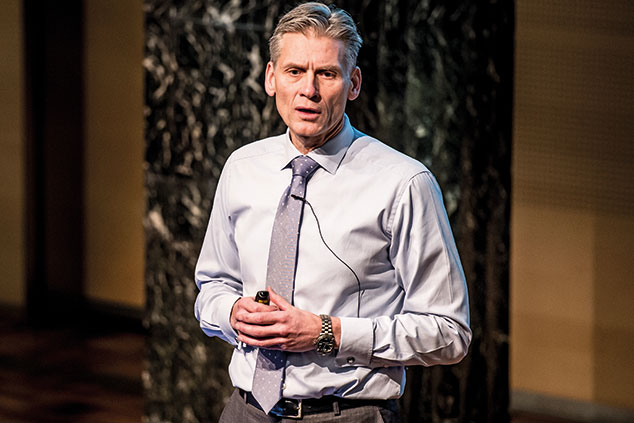
What has happened?
Danske Bank, until recently one of Europe’s most respected financial institutions, is at the centre of possibly the world’s biggest money-laundering scandal.
Its chief executive, Thomas Borgen, was ousted this week over revelations about dubious flows of funds through its Estonian branch. The affair has its roots in 2007, when Danske took over Finland’s Sampo Bank, including its branch in the Estonian capital, Tallinn.
During the eight years from then until 2015, an astonishing €200bn of non-resident money – mostly from Russia, Ukraine, Azerbaijan, Moldova and other ex-Soviet states – flowed through the branch, according to a report commissioned by the bank from law firm Bruun & Hjejle.
Not all of that money was necessarily dodgy, of course. But investigators have so far examined 6,200 of the 15,000 non-resident accounts opened during the period, and say the “vast majority” of them are suspicious.
Why didn’t anyone notice?
They did. Almost as soon as Danske acquired its Estonian outpost, Estonia’s financial regulator criticised the Danish bank for underestimating compliance risk and having problems with know-your-customers rules.
Russia’s central bank warned Danske that the branch was being used for nefarious transactions – either tax evasion or money laundering to the tune of billions of roubles a month. This warning was ignored.
In 2008 Danske cancelled plans to move its Baltic subsidiaries onto the bank’s main IT platform, meaning – incredibly – that the Tallinn branch did not deploy the same anti-laundering checks as the head office in Copenhagen.
Did it prove profitable?
Yes. The fact that no-one took action might be explained by the fact that the Estonian branch was generating 11% of Danske’s total profits, while accounting for 0.5% of the bank’s assets (and the fact that non-residents accounted for up to 99% of the Estonian profits).
The non-resident business continued to flourish even after JP Morgan withdrew as Danske Bank Estonia’s correspondent bank for dollars in 2013, concerned it was being used to channel dodgy funds.
It was only in 2014 that Danske’s senior management began to wind down the business, after a whistleblower – who has been named by the Danish press as Howard Wilkinson, the British former head of Danske’s trading business in the Baltics – alerted them to the use of the branch for alleged money laundering by a London-registered limited liability partnership (LLP).
What exactly is money laundering?
It’s a generic term that describes any process by which criminals can disguise, move or spend their ill-gotten gains by transforming “dirty” money into legitimate “clean” assets. Estimates from the likes of the UN and IMF suggest the amount of money laundered each year is in the region of 3%-5% of global GDP.
A very basic form of money laundering is simply to take a bagful of cash to another jurisdiction and deposit it in a bank. A step up from that might be for a mafia-type organised crime gang to run a “legitimate” cash-intensive business (a car-wash, a casino, a restaurant, say) as a front though which it can channel and launder cash. More sophisticated laundering uses financial products for the same ends.
Is it a big problem?
Danske Bank isn’t the only bank to be caught out. Last month the Dutch bank ING was fined €775m over a laundering scandal. Last year Deutsche Bank paid a total of $630m to US and UK regulators over “mirror trades” through its Moscow branch, which were allegedly used to launder $10bn out of Russia. Analysts at Jyske Bank have predicted a global fine of as much as $8bn for Danske if wrongdoing is proven, says the FT.
Since the financial crisis, banks have paid more than $300bn in fines for wrongdoing, but Oliver Bullough, whose recent book Moneyland explores how kleptocrats have exploited Western financial and legal systems, thinks the problem may be the tip of an iceberg, he tells the FT.
“We only know about Danske because Wilkinson stuck his head above the parapet, but how many other banks in the Baltics were doing exactly the same thing?”
How is London involved?
Many of the entities sending money through Estonia were shell companies registered in the UK or its overseas territories, and the National Crime Agency has opened an initial investigation into potential criminal wrongdoing.
The now-dissolved company, whose ultimate owners were alleged to be the family of Vladimir Putin, was Lantana Trade LLP, whose registered address (the FT reported last week) was in the UK. But it was just one of perhaps thousands of similar vehicles.
According to Danske’s report into the affair, UK entities such as LLPs and SLPs (Scottish limited partnerships) made up the second biggest proportion of Danske Estonia’s non-resident customers – second only to those based in Russia.
Why are they so popular?
The fact that Britain is home to a major global financial centre means it is always going to attract people wanting to launder cash. But inevitably the Danske scandal has intensified questions over the ease with which LLPs and SLPs can be misused, providing anonymous shell companies with a UK wrapper by registering through an official formation agent for as little as £50.
UK regulators have tried to clamp down on their misuse – for example, by forcing all companies, including LLPs, to divulge who their “person of significant control” is. The UK government is now considering further measures, such as requiring LLPs to have a principal place of business in the UK, while campaigners are urging far greater control and scrutiny of the agents who form the companies.
So far, says Caroline Binham in the FT, “there has only been one prosecution of a person for filing false information to Companies House. It turned out he was a campaigner showing how easy it was”.